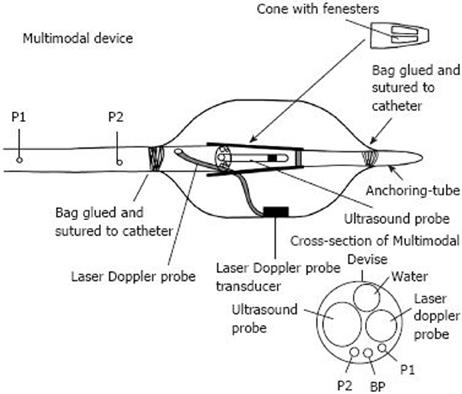Copyright
©2009 The WJG Press and Baishideng.
World J Gastroenterol. Jan 14, 2009; 15(2): 198-203
Published online Jan 14, 2009. doi: 10.3748/wjg.15.198
Published online Jan 14, 2009. doi: 10.3748/wjg.15.198
Figure 1 A schematic depiction of laser Doppler perfusion monitoring showing the probe with its emitting fibre bundle which applies monochro-matic laser light to the tissue, and its receiving fibre bundle which returns reflected light for analysis.
The light that has undergone a doppler shift due to moving blood cells in the tissues reflects the microcirculatory perfusion at a given time. Reproduced by permission of Perimed AB.
Figure 2 The capillary network showing also precapillary sphincters which regulate perfusion locally in response to metabolic needs, and shunts which participate in thermoregulation.
Figure 3 The multi-lumen PVC catheter (Outer Diameter = 6.
0 mm) and a distal bag for acoustic coupling and symptom provocation. A water perfused manometric system measures pressures inside the bag (BP) and proximal to the bag at locations P1 and P2. The end of the multi-lumen catheter was attached to a fenestrated cone of polyethylene. The distal end of the cone was attached to a smaller end mounted catheter (anchoring-tube) for distal attachment to the bag. A 20 MHz ultrasound probe was placed in the centre of the bag and the transducer of the laser Doppler probe (780 nm) was fixed with double-sided tape to the inner surface of the bag. Modified from Hoff et al[34], 2006.
- Citation: Hoff DAL, Gregersen H, Hatlebakk JG. Mucosal blood flow measurements using laser Doppler perfusion monitoring. World J Gastroenterol 2009; 15(2): 198-203
- URL: https://www.wjgnet.com/1007-9327/full/v15/i2/198.htm
- DOI: https://dx.doi.org/10.3748/wjg.15.198











